Interesting, Weird, Strange Freshwater Fishes
-
Ok, as some of you may know, I have my so called FishFile thread but that is like all expired now.
Would be good to have a nice collection under 1 thread where others can contribute too. Some of the features may have been posted before but this is just to collate everything together.
Remember. It has to be Fresh or Brackish water fish. No fish found in the ocean please. Thanks
To start off:
Vampire Catfish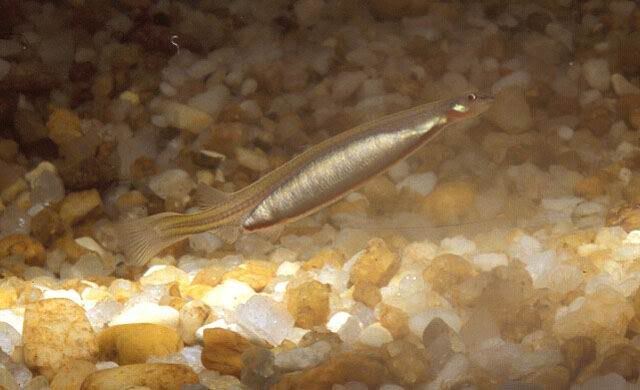
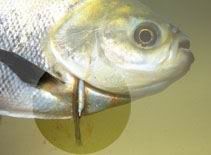
Family: Trichomycteridae (Pencil or parasitic catfishes)
Order: Siluriformes (catfish)
Class: Actinopterygii (ray-finned fishes)
Max. size: 5.0 cm SL (male/unsexed; Ref. 50921)
Environment: demersal; freshwater
Climate: tropical
The candirú or canero (Vandellia cirrhosa) or Toothpick Fish is a freshwater fish in the group commonly called the catfishes. It is found in the Amazon River and has a reputation among the natives as the most feared fish in its waters, even over the piranha. The species grows only to a size of an inch in length and is eel shaped and translucent, making it almost impossible to see in the water. The candiru is a parasite. It swims into the gill cavities of other fishes, erects a spine to hold itself in place, and feeds on the blood in the gills, earning it a nickname as the "vampire fish of Brazil".
It is feared by the natives because it is attracted to urine or blood, and if the bather is nude it will swim into an orifice (the anus or vagina, or even in the case of smaller specimens the penis - and perhaps deep into the urethra). It then erects its spine and begins to feed on the blood and body tissue just as it would from the gills of a fish. The candiru is then almost impossible to remove except through an operation. As the fish locates its prey by following the water flow from the gills to its source, urinating while bathing increases the chance of a candiru "homing in" on a human urethra.
A traditional option is the use of two plants, the Xagua plant (Genipa americana) and the Buitach apple which are inserted (or their extract in the case of tight spaces) into the affected area. These two plants together will kill and then dissolve the fish. More often, infection causes shock and death in the victim before the candirú can be removed.
If anyone is interested, you can follow this link to see the surgical procedure of removing the fish from a human. Pretty graphical pictures...
http://www.angelfire.com/biz/piranha038/candiru.html
References of Article and Images:
http://www.fishbase.org/Summary/SpeciesSummary.php?id=8811
http://en.wikipedia.org/wiki/Candiru -
Freshwater Stonefish

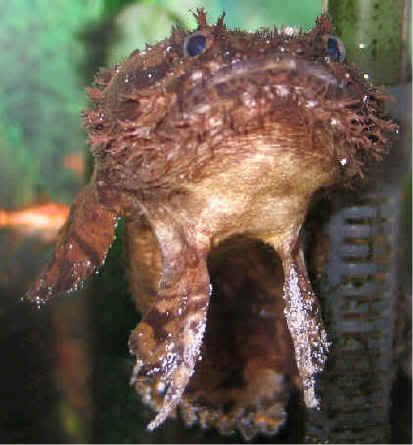
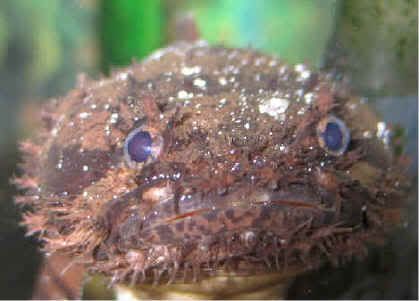
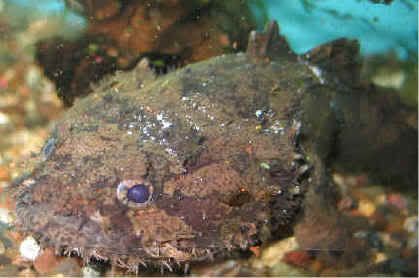
Some General Information
Common Name: Freshwater Stonefish/Lionfish/Toadfish/Frogfish
Scientific Name: Batrachus trispinosus
Distribution: N.W. Australia, Thailand, Indonesia, New Guinea
Diet: Likes Fish, especially live fish
Temperament: .....it's a predator! What do you think? They are supposed to be nocturnal.
Tankmates: Seems that they are best alone with same species but I should think that it should be fine with something it can't eat and will not try eating it.
Other Comments: Please note that these are venomeous so do not try touching them.Freshwater stonefish skulk 98% of the time. In some cases they get behind bulky objects in their tank. In others, they wedge themselves into a corner or cave. Big guys sometimes just loaf on the bottom looking like a big lumpy stone. Thus the name. Upon occasion your freshwater stonefish will stomp around on his specialized fins. HeÂ’s about as graceful as a toad.
Species Stats
Temperature: 27°C - 29°C
Water: Brackish; Does not take poor water conditions well
Max Size: 12 inches
Information & Pictures taken from:
http://www.aqualandpetsplus.com/Oddball,%20Stonefish.htm -

reminds me of Oscar the Grouch!
-
Freshwater Electric Eel (Electrophorus electricus)
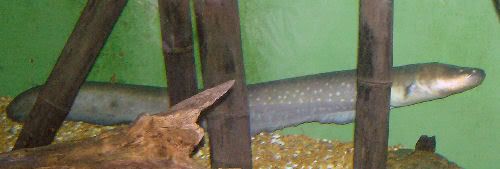
The Electric Eel is an amazing creation of nature. While many fish are able to create an electrical charge to use as “radar”, this is one of the few species that can create a charge that’s strong enough to disable its prey!
Even though it is eel shaped, the Electric Eel is not a true eel but is more closely related to many of the knifefish that are found in South America.
Because of their ability to generate a strong electrical charge, this large animal is definitely a candidate for a single species aquarium. They can grow as large as 8 feet long and can weigh as much as 45 pounds although the size attained in an aquarium will be smaller. They are not a particularly active fish so they will not need a tank as large as other species their size would require. If the tank is longer that the fish is and it has plenty of room to turn around, it should suffice but remember that even in captivity, this fish can grow to over 4 or 5 feet.
Electric Eels are very hardy but avoid specimens that are less than 1 foot in length. For some reason, the smaller ones tend to be weak.
The Electric Eel dwells in the freshwater rivers of the lower Amazon basin in South America. The rainforest environment provides a diet of smaller freshwater fish, and amphibians.
Although the Electric Eel is occasionally eaten by local people in the Amazon, it is largely avoided due to its ability to deliver a powerful shock. When the eel is caught in fishermen's nets, the other fish are often found dead due to the shocks from the eel. It has been known to discharge electric shocks up to eight hours after death due to continued activity in the electric organs along the eels tail.
Another distinguishing feature about the Amazon river habitat is the low concentration of dissolved oxygen in the water. For this reason the eel surfaces frequently, as previously mentioned, to gain sufficient oxygen for respiration. Up to 78% of the total oxygen intake is from the atmosphere, as opposed to the 22% extracted by the gills. Emission of carbon dioxide is done primarily through the skin (81%), but a small amount of C02 is emitted through the mouth (19%)
Care and Feeding
Electric Eels are predatory fish, carnivores that will eat almost any animal thatÂ’s small enough to fit into their mouth. In the wild this mainly includes fish, invertebrates and small mammals. You will probably have to feed them live fish at first but usually they can be trained to eat dead freshwater fish such as defrosted frozen smelt.
Distribution
The Electric Eel is a very common South American fish and is found throughout most of the Amazon and Orinoco basins.
Size - Weight
These fish can get up to 8 feet long (250 cm) and can weigh as much as 45 pounds (20 kg), they are usually smaller in the aquarium reaching only about 4 - 5 feet (125 - 152 cm)..
Social Behaviors
The Electric Eel is not aggressive but due to its method of catching its prey, it is suitable only for a single species aquarium.
Sexual Differences
There are no known external sexual differences.
Water Region: Top, Middle, Bottom
They will spend most of their time resting on the bottom of the aquarium.
Acceptable Water Conditions
The Electric Eel is not very fussy about Ph or water hardness.
Temp: 74-82 F (23 – 28°C)
Breeding/Reproduction
Has not been bred in captivity.
References:
http://www.chm.bris.ac.uk/webprojects2001/riis/electriceels2.htm
http://animal-world.com/encyclo/fresh/Eels/ElectricEel.php -
Freshwater Flounder
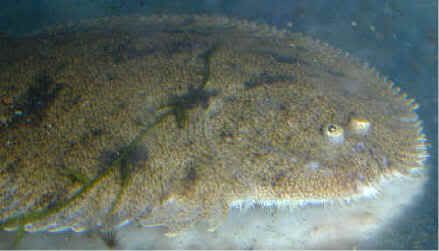
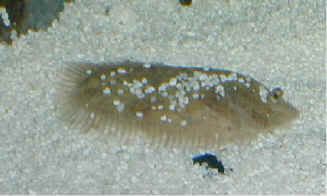
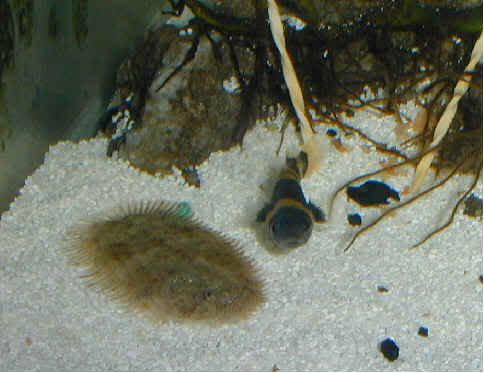
Some General Information
Common Name: Freshwater Flounder
Other Common Names: Lined sole
Scientific Name: Achirus lineatus
Other Scientific Name(s): Pleuronectes lineatus
Distribution: Western Atlantic: Florida, USA and northern Gulf of Mexico to northern Argentina.
Diet: If itÂ’s small and moves, freshwater flounders try to eat it. Live blackworms or small earthworms work well to start with. Add some feeder white clouds also. TheyÂ’d probably also enjoy ghost shrimp as they grow. You can eventually convert them over to frozen brine shrimp and frozen bloodworms. Some eventually convert to eating flakes or sinking pellets. Most community fishes will eat all the flakes before the flounders start looking for them. Flounders have an eating advantage at night
Temperament: Very calm, never bothers other fish but is known to be picked on by most species.
Tankmates: Feel free to mix these guys with other medium-sized brackish water fishes – African butterflies, dragon gobies, African ropefish (if your flounder’s too big to swallow), mollies, and other livebearers (because they like salt also). Livebearers also provide additional live food periodically.
Color: Freshwater flounders try to blend into whateverÂ’s on the bottom. They can control the size of their various pigment pores to change from dark to light in the greys and browns. Some develop spots to complete the camouflage.
Other Comments: They need good filtration, likes to suck onto the glass and hang out on the bottom, needs sand! if u have gravel along with sand its gotta be rounded so it doesnt cut the flounder's soft belly.
Like the other flounders, these weird little guys have both eyes on one side of their bodies. Their left eye migrates to the right side of their bodies. The left side becomes its whitish underbelly. They spend all their time lying on their underbellies.
Species Stats
Min. Tank Size: 10 gallons
Temperature: 79 °F or about 26°C
Water: Slightly Brackish Water. About 2 teaspoons of salt per gallon. Increase the amount of salt as your flounders increase in size.
pH: 7.0
Max Size: 5 - 6 inches
Information & Pictures taken from:
http://species.fishindex.com/species_3315achirus_lineatus_freshwater_flounder.html
http://www.aqualandpetsplus.com/Oddball,%20Flounder.htm[/b] -
Originally posted by elindra:
This is one of the deadly creatures Steve Irwin was talking about on his last fatal documentary - Ocean's deadliest.
[b]Freshwater Stonefish
[/b] -
That is it's ocean relativeOriginally posted by honeymouse:This is one of the deadly creatures Steve Irwin was talking about on his last fatal documentary - Ocean's deadliest.
This is the freshwater one which is deadly too -
Land Catfish
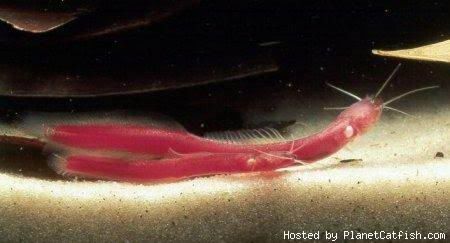
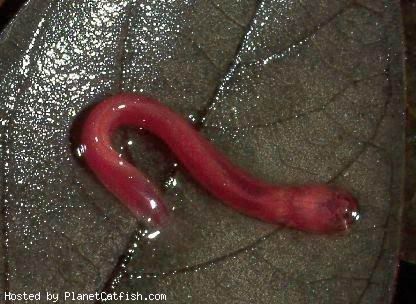
Scientific Name: Phreatobius sp.(1)
Common Name: Land Catfish
Size: 1.2"
Notes on ID:
Not surprisingly this species has yet to be imported as an aquarium fish. They are reportedly rare in the wild but this is more likely because of insufficient distribution data, unimportance to the local people and the small size of the fish than true scarcity.
Sexing: Unknown
Distribution: Brazil
General Information:
It is labelled Phreatobius walkeri in the Guinness book of records (GBOR), but this is a ''nomen nudum'' (literally a naked name) which means that this name is not scientifically valid and indeed cannot be used in future. It is stated within the GBOR that, ''this is the only known fish in the world that solely lives on land. Other fish species (including some other catfish) can spend some of their time on land, but not all their time''. From a ''certain point of view'', this makes this catfish the ''newest fish on land''! In truth this isn't quite right - it's not DRY land. This Phraetobius is only and always found within the sodden leaf litter banks by the stream edges. As you can see it is a small, wormlike catfish and was found in the middle of the 1980s in Brazil. This species lives a full life on ''land'' among fallen leaves near the river. It is reported that if it is returned to water, it will quickly jump out of it again, but this seems unlikely. This fish is currently placed in the Heptapteridae family but has many similarities with the Trichomycteridae. Its ''halfway house'' characteristics might even merit the creation of a new catfish family. Many authors consider this genus a junior synonym of Heptapterus.
Information Taken From:
http://www.planetcatfish.com/scripts/clog_link.php?q=phreatobius+sp(1) -
Originally posted by elindra:
scary
[b]Land Catfish

Scientific Name: Phreatobius sp.(1)
Common Name: Land Catfish
Size: 1.2"
Notes on ID:
Not surprisingly this species has yet to be imported as an aquarium fish. They are reportedly rare in the wild but this is more likely because of insufficient distribution data, unimportance to the local people and the small size of the fish than true scarcity.
Sexing: Unknown
Distribution: Brazil
General Information:
It is labelled Phreatobius walkeri in the Guinness book of records (GBOR), but this is a ''nomen nudum'' (literally a naked name) which means that this name is not scientifically valid and indeed cannot be used in future. It is stated within the GBOR that, ''this is the only known fish in the world that solely lives on land. Other fish species (including some other catfish) can spend some of their time on land, but not all their time''. From a ''certain point of view'', this makes this catfish the ''newest fish on land''! In truth this isn't quite right - it's not DRY land. This Phraetobius is only and always found within the sodden leaf litter banks by the stream edges. As you can see it is a small, wormlike catfish and was found in the middle of the 1980s in Brazil. This species lives a full life on ''land'' among fallen leaves near the river. It is reported that if it is returned to water, it will quickly jump out of it again, but this seems unlikely. This fish is currently placed in the Heptapteridae family but has many similarities with the Trichomycteridae. Its ''halfway house'' characteristics might even merit the creation of a new catfish family. Many authors consider this genus a junior synonym of Heptapterus.
Information Taken From:
http://www.planetcatfish.com/scripts/clog_link.php?q=phreatobius+sp(1)[/b]


-
Shouldn't the scary fish be the vampire catfishOriginally posted by crofty:scary


-
I just find the land catfish more scaryOriginally posted by elindra:Shouldn't the scary fish be the vampire catfish
-
Maybe it's coz they look like a bloody wormOriginally posted by crofty:I just find the land catfish more scary

Will post more soon when I'm free
-
Amazon Leaf Fish
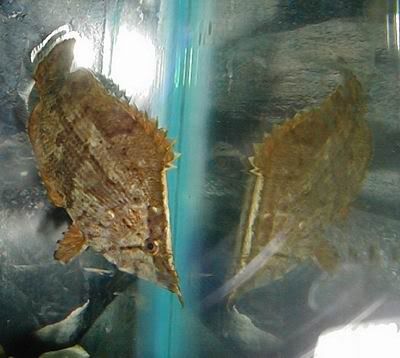

Common Name: Amazon Leaf Fish
Scientific Name: Monocirrhus polyacanthus
Family: Nandidae (Leaffishes)
Subfamily: Nandinae
Order: Perciformes
Class: Actinopterygii (ray-finned fishes)
Max. size: 10.0 cm
Environment: benthopelagic; freshwater; pH range: 5.0 - 6.0; dH range: 5.0 - 8.0
Climate: tropical; 22 - 25°C
Distribution:South America: Guyana to Brazil. Found in the Peruvian Amazon (Ref. 6329).
Care: Very difficult fish to keep, definitely not for beginners! Monocirrhus polyacanthus are true predators. They are best not accompanied by other fish, although they can be accompanied by diskusfish, angels, and larger Corydoras species. Leaf fish can only be fed live food, juveniles will accept small live food like bloodworms. Older specimens are more picky, and require live fish. They eat approximately their own weight per day, so to keep them properly, you'll need a few tanks in which feeder fish can be bred, or have lot's of money to spend.
A pair can be kept in an 80 cm aquarium, although the larger the better. The tank should be well planted, especially with plants that have large leaves, like Echinodorus species, in between which the leaf fish loves to hide. They are extremely good at hiding, and it will always take some time before you spot them in the aquarium. A dark soil and some floating plants will be appreciated by the fish, but are no necessity. Some driftwood is definitely recommended!
Breeding: At a lower pH(below 6) the fish will spawn in a setup as described in the care section, and if fed well. Up to 300 eggs, which hang by a thread on a leaf, are deposited by the female, and guarded by the male.
At 25 degrees, the eggs will hatch in 4 days, and the fry are around 5 mm. If fed well, they can reach 3 cm in 3 months.
Sexual dimorphism: Recognisable at 4 cm, females display a ovipositor.
Additional Information: Do not use guppies as feeder fish! Many guppies are infected with fishtuberculosis, and leaffish are highly susceptible to TBC, and may contract it through the feeder fish.
Life expectancy: 8-9 years.
References:
http://www.nscontact.com/catalogue/-nsc-en_60_51_01_390_1_Monocirrhus_polyacanthus_Amazon.aspx
http://aquaworld.netfirms.com/Other/Monocirrhus_polyacanthus.htm
http://www.geocities.com/willowdaleaquariumsociety/library/leaf.html -
anyone know what fish is this ??
Fish Caught From The Congo River
-
kinda scare meOriginally posted by meltz:anyone know what fish is this ??
Fish Caught From The Congo River
 ok,I think it is the hydrocyninae
ok,I think it is the hydrocyninae 
-
African Tiger Fish..
very aggressive.. -
the freshwater flounder in the first pic looks so cute and cuddly...


-
Bear answered before meOriginally posted by the Bear:African Tiger Fish..
very aggressive..
-
African Tiger Fish



Common name(s): African Tiger Fish, ATF, Tiger Fish
Scientific Name: Hydrocynus vittatus, or Hydrocynus forsksahlii (Slimmer and yellowish tail)
Family: Alestiidae
Origin: Africa
Size: 18 - 32 inches in captivity. Between the two species, ATFs can grow to over four - five feet, but in aquariums, less than half to about half of that is expected at the maximum.
Minimum Tank Size: 125 US gallons - 6' long minimum (the longer, the better!)
Care: Let's take in mind the enclosure first; because of this fish's strength, speed, and size, a very large tank is important. I've successfully kept a small one in an 80 Gallon, but when he gets larger, he'll need much more room... I would suggest 125 at a bare minimum. The bigger the better. A 240 or more would be reasonable. The reason such a tank is needed is because these fish can seriously hurt themselves by running into the glass if it is too small of an area. Within your large tank, large plants (like swords) and larger-sized tankmates (bottom dwellers - NOT mid-dwellers) are okay, but rocks, sharp objects, and other hard objects are to be left out. A tiger fish can fatally wound itself if running into objects as hard as rocks or as sharp as, i don't know, a sharp rock. This is especially true when they hunt. When attacking its prey, they're likely to charge at it seemingly full force. Whatever is behind it's prey, the tiger fish will most likely run into. Don't under-estimate the power these fish output. Standard lighting, heating and filtration is clearly necessary. Keep a good cover on the top of the tank. These fish are very gutsy jumpers if they need to be. Substrate type is unimportant, as these fish are mid-dwellers. Keep water chemistry in good quality (common sense). Nitrites and nitrates should be an attempted zero, and try to keep pH steady at 7.2 to 7.6. Never forget water changes weekly and clean out any leftover "fish-bits" that the ATF hasn't eaten. It is recommended here and there to keep them in small shoals - 5 minimum.
Feeding: Guppies, Ghost Shrimp, Rosy Reds... ...etc. Do not dump feeder fish straight in from the store, quarantine them long enough until you can tell they are safe to feed. Some ATF owners have swayed their fish to eat non-live meaty food, but a lot of ATFs will not eat unless their food is "fun" and hard to catch - it seems that they like a challenge, and would get bored eating prepared or frozen foods.
Sexing: No physical determination.
Breeding: Unknown in captivity
Written by Wonderboy from
http://www.fishforums.net/index.php?showtopic=134743